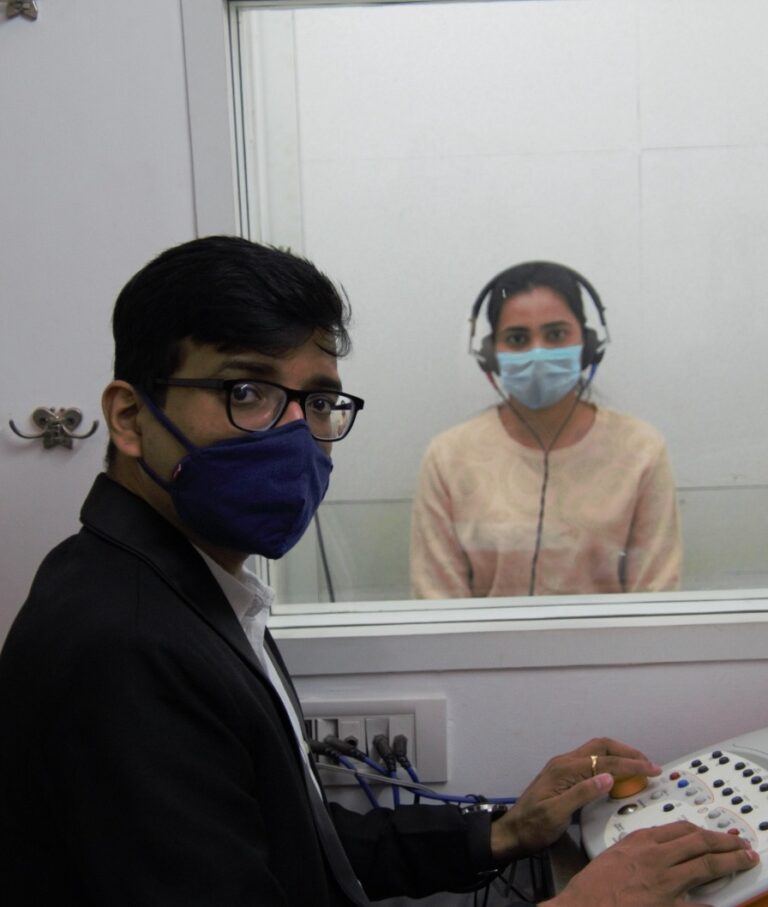SENSORINEURAL DEAFNESS
One of the commonest forms of hearing loss is Sensorineural hearing loss – SNHL.
The other forms of hearing loss are Conductive hearing loss, mixed hearing loss and non-organic hearing loss (Functional hearing loss – Pseodohypoacusis).
Sensorineural is actually two words –
- Sensory- Related to the ‘sense organ’ – in this case the Cochlea.
- Neural – Related to the Nerve of hearing – Acoustic Nerve – and beyond.

Causes of SNHL
- Congenital – Some babies are born deaf. This may be due to various reasons including consanguinity, antenatal illness, medication during pregnancy (specially during the first trimester), genetic history of hearing loss etc. All Nursing homes and Hospitals are mandated to do a hearing screening test of the newborn as per the Universal Neonatal Screening Programme. The baby’s hearing is tested using OAE (Otoacoustic transmission). This is done before the baby is discharged from the hospital.
The purpose of this screening is to determine hearing loss early so that appropriate intervention including Cochlear Implantation can be done at the best possible age- usually between one and 4 years of age.
- Trauma is a common cause of Sensorineural hearing loss. This is usually due to head trauma, and there is usually bleeding from the ear following the trauma
- Infections- Most commonly Viral or Bacterial infections can cause a hearing loss. This could be due to an ear infection directly or due to Meningitis etc. Middle ear infections usually lead to a conductive deafness but repeated infections can cause toxins released by the bacteria to seep via membranes into the inner ear and cause a mixed or sensorineural hearing loss.
- Sudden SNHL – on certain occasions there is sudden loss of hearing in one ear which may be either due to Vascular or Viral causes. The cause remains largely Idiopathic – unknown.
- Exposure to loud sound – as our environment has become noisier there is a direct impact on our hearing. Exposure to loud ambient noise including loud speakers during music festivals or ‘DJ’ parties may lead to hearing loss
- Medication- some medicines including Streptomycin, Gentamycin, Anti cancer drugs, Frusemide etc may cause irreversible hearing loss or imbalance as a side effect.
DIAGNOSIS
- ENT EXAMINATION- Based on the history of hearing loss a thorough ENT Examination is done
- AUDIOGRAM – including a Pure Tone Audiogram which is a basic test along with other specialized tests if needed.
- IMAGING – including an MRI or a CT Scan in certain cases
- OTHER INVESTIGATIONS , including blood tests, cardiac evaluation where required etc.
HEARING REHABILITATION
In our current situation the only treatment for SNHL is by the use of an appropriate hearing aid.
Hearing aids are of various types and that is discussed elsewhere.
There is a d9ifference in the two types of hearing loss
- Sensory- Cochlear deafness suffers from a peculiar phenomenon called loudness recruitment. In practical terms it means that if the volume is raised too high they find it very uncomfortable because of the phenomenon of ‘Recruitment.’ The software in the hearing aids is programmed keeping this phenomenon in mind
- Neural- Since the Acoustic Nerve and the brain may be involved simple amplification just makes the patient more confused – ‘ I can hear the sound but I do not understand what is being said.’
The newer hearing aids however are a marvellous bit of technology that offer great relief and enable the hearing impaired to hear again.

Address
D 3/14, Ground Floor
Vasant Vihar
New Delhi 110 057
Mobile: +91 98711 50032
Hour of Operation
Monday To Saturday
Morning Timing
09:30 AM to 11:30 AM
Evening Timings
4:30 PM to 7:00 PM
Thursday Morning Clinic Is Closed
Thursday Evening
4:30 PM to 7:00 PM
Let's Get In Touch. Contact us.
Get Connected

Get In Touch
Subscribe For Health Updates

